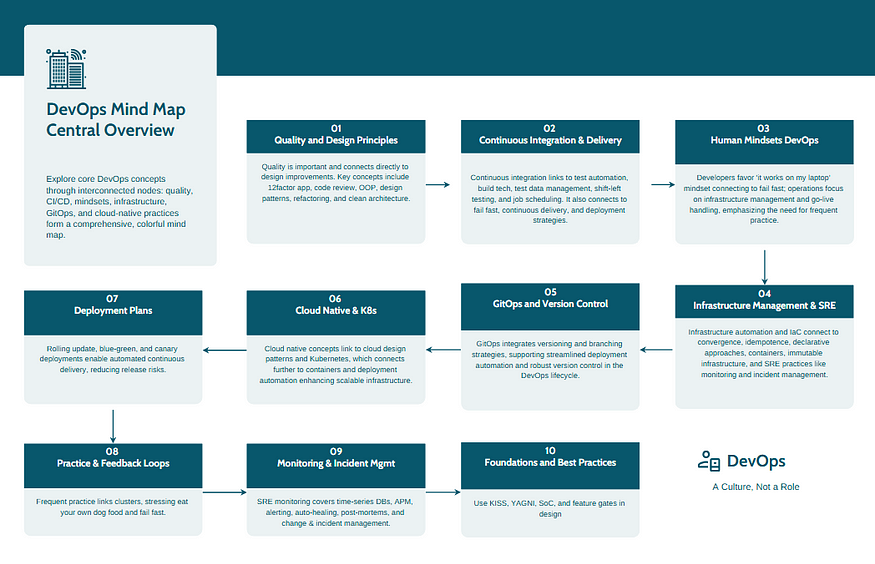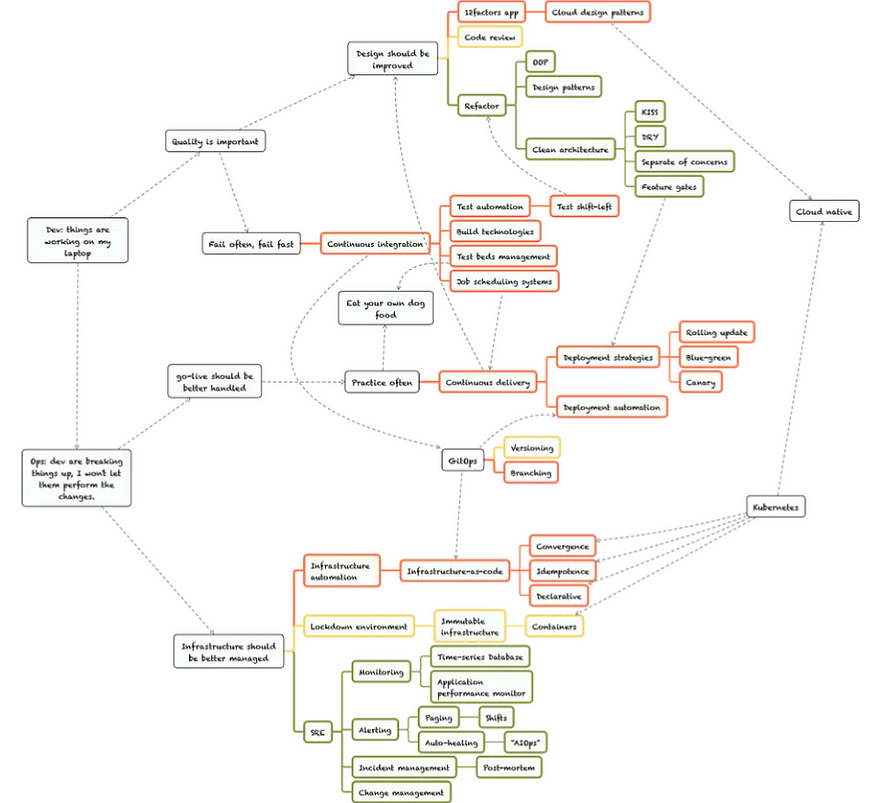DevOps Mind Map: A Reflection on My Journey
 Vinay K N
Vinay K N
DevOps Mind Map: A Reflection on My Journey
With over 7 years of hands-on experience in the DevOps landscape from writing my first Jenkins CI pipeline in 2018 to deploying resilient Kubernetes clusters and implementing SRE principles, I’ve come to understand that DevOps is far more than just a toolset or job title. It’s a mindset and a journey of continuous improvement. Along the way, I’ve mentored junior engineers and built automation workflows, delivery pipelines, and fault-tolerant infrastructure. To guide others navigating this space, I created a visual DevOps Mind Map to capture the philosophies, systems, and challenges that define this field.

DevOps: A Culture, Not a Role
Before diving into tools or technologies, it’s essential to understand that DevOps isn’t just a methodology or a process, it’s a shift in culture. At its core, DevOps breaks down the silos between development and operations, encouraging collaboration, automation, and shared responsibility for delivering software. It’s not about simply adopting CI/CD or containers, but about aligning people, processes, and platforms to create a seamless flow of value from idea to production.
Software Design: The Foundation of Reliability
DevOps begins at the code level. Writing maintainable, scalable, and testable software is critical for any automation to work effectively. Design paradigms such as the 12-Factor App, clean architecture, and separation of concerns provide a structured approach for building robust services. Embracing object-oriented principles, design patterns, and clean code practices ensures that your applications remain sustainable and adaptable to change. Principles like KISS (Keep It Simple, Stupid) and DRY (Don’t Repeat Yourself) are not just catchphrases they are foundational guidelines that help safeguard your systems against long-term technical debt.
Continuous Integration: Catch Issues Early
Continuous Integration (CI) plays a pivotal role in ensuring code quality. By frequently merging code changes and running automated tests, teams can identify and fix issues early in the development cycle. CI encourages test automation, build orchestration, and integration testing in a repeatable and reliable manner. Emphasizing “fail fast, fail often,” CI transforms failure into a feedback mechanism, allowing developers to catch problems on their machines before they reach production. Incorporating job schedulers, test environments, and quality gates also helps create a healthy engineering ecosystem.

Continuous Delivery: Shipping with Confidence
The goal of Continuous Delivery (CD) is to ensure that code is always in a deployable state. CD builds on CI by adding automated deployment workflows, infrastructure provisioning, and promotion strategies. Here, deployment automation and progressive delivery techniques such as canary releases, blue-green deployments, and rolling updates ensure that new features are introduced gradually and safely. Rather than fearing deployments, CD empowers teams to release more frequently with less risk. By practicing go-lives regularly and using real-world feedback, organizations can achieve greater agility and resilience.
GitOps and Source Control as the Backbone
Version control is the heartbeat of DevOps. Everything from application code to infrastructure configuration lives in Git, creating a single source of truth. GitOps is an operational model where infrastructure and environments are declared as code and managed via pull requests, making change management visible, auditable, and traceable. Effective branching, tagging, and rollback strategies ensure that developers can collaborate with confidence and revert changes when needed without downtime or disruption. Git becomes more than just a versioning tool it becomes the engine of deployment and governance.
Infrastructure as Code: Managing the Machine
Infrastructure as Code (IaC) revolutionizes how we manage infrastructure by allowing it to be defined, versioned, and deployed just like application code. With tools like Terraform, CloudFormation, or Pulumi, engineers can declaratively describe environments that are repeatable and testable. This ensures consistency across development, staging, and production. Key principles like idempotence and convergence help maintain state integrity, while modular and composable infrastructure blocks simplify the complexity of large-scale environments. IaC enables infrastructure to be self-documented, scalable, and easy to audit.
Automation & Resilient Operations
Beyond provisioning, infrastructure must be automated, secured, and continuously improved. Practices like enforcing locked-down environments, using immutable infrastructure, and managing secrets safely reduce the risk of human error. Monitoring systems, alerting, and logging provide visibility into system behavior, allowing teams to respond proactively. Time-series databases, APMs, and log aggregators reveal performance bottlenecks and failure points in real time. With these insights, teams can build systems that are both secure and self-healing.
Site Reliability Engineering (SRE): Bridging Dev and Ops
Site Reliability Engineering brings a formalized structure to what DevOps aims to achieve reliability at scale. SRE emphasizes observability, automation, and resilience through defined Service Level Objectives (SLOs) and Indicators (SLIs). Incidents are treated as learning opportunities, with detailed postmortems, root cause analysis, and improvements. Auto-scaling, error budgets, and chaos testing help ensure that systems stay available even under pressure. By combining software engineering with operations, SRE blurs the lines between the two disciplines, aligning teams around shared goals of uptime, latency, and performance.
DevOps: A Continuous Compass
The DevOps Mind Map is not a checklist, nor is it prescriptive. Instead, it’s a compass to guide your growth, help teams align on best practices, and expose areas of opportunity. Each organization will walk its own DevOps path — there is no one-size-fits-all approach. But by focusing on automation, observability, collaboration, and continuous improvement, teams can transform the way software is built and delivered.
Final Thoughts
Looking back, this journey has been about more than just writing pipelines or deploying to the cloud, it’s been about embracing a new way of thinking. DevOps isn’t a destination. it’s a cultural shift that fosters ownership, speed, and stability. Whether you’re mentoring juniors, scaling infrastructure, or optimizing delivery pipelines, the DevOps mindset will continue to be your greatest asset.
Let’s connect and share our DevOps journeys! 🤝
Connect with me on LinkedIn
Subscribe to my newsletter
Read articles from Vinay K N directly inside your inbox. Subscribe to the newsletter, and don't miss out.
Written by
